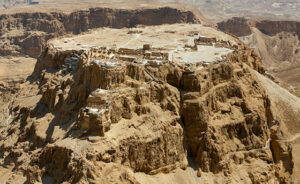It comes to reaching the top of Masada, the ancient remains of King Herod’s fortress built in 30 BC on a plateau overlooking the Dead Sea, you are either among the “trammers” or the ‘“climbers.” The trammers pay to take the enjoyable cable-car. It’s a 2:23 minute relaxing ride up.
The climbers are the ones who take the Snake Path up the face of the mountain. And due to its twists and turns, it’s twice the distance and can take between 38 minutes (Olympic level) or 2:28.3 hours (Millerympic level).
On a visit several years ago, I took my teenage son and newly Bat Mitzvahed daughter. Each was determined to take the Snake Path as they announced, near all those in line, that the tram was for the weak and elderly. (Come along children….)
No more than 10 minutes in, each step came with its own kvetch. People heard us walking and great-grandparents carrying backpacks passed us going up.
We finally made it to the top. Pouring water over our heads, we owned the feeling of genuine achievement. It was worth the climb.
After learning of how the Jews survived atop Masada, it was time to go down. Understandably, the children wanted to take the tram. And so we did.
And here comes the fascinating part. On our descent, enjoying the breeze, my son had a contemplative and disappointed expression. When I inquired about it, he said, “Abba, as hard as that climb was, coming down after all that effort feels harder, in a different way.” I understood that the further down the mountain we traveled, the further we felt from that awesome sense of determination we had experienced on the way up.
We are now “coming down” from the month of Tishrei, with the preparations and celebrations of Rosh Hashanah, Yom Kippur, Succot, and Simchat Torah. We are making our descent into the month of Cheshvan, which has no Jewish holidays.
Like climbing up Masada, the High Holidays invited us to get a glimpse of our stronger selves. We got more connected, more invested in Jewish life, more thoughtful about where we placed our energy. We climbed the Tishrei mountain.
The greatest opportunity of the High Holidays, though, is perhaps not the High Holidays themselves, but in the days following. Our next mission is remaining connected to the strength and determination we now know we have, to commit to live by our values in day-to-day life with our children, as we walk, hike, and tram together.
Rabbi Shmuel Miller has been involved in Jewish communal work for over three decades and is an engaging presenter to parents and children. Rabbi Miller is the Chief Operating Officer of Irvine Hebrew Day School and can be reached at rabbimiller@irvinehebrewday.org.







